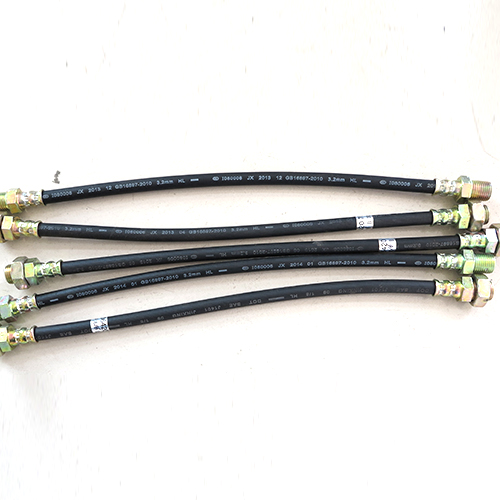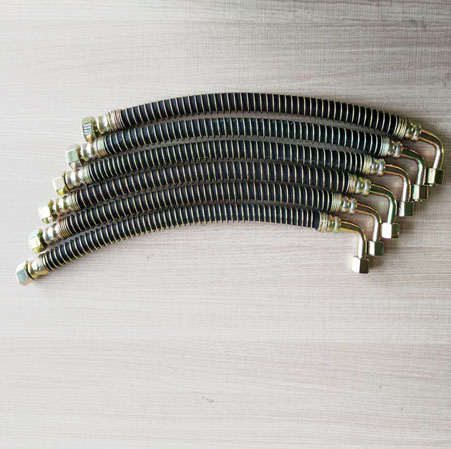© 2024 Power Automedia. All rights reserved.
Automotive plumbing – be it for brakes, fuel system, or whatever, typically doesn’t get much pre-planning before the process actually gets underway. That’s a shame, because the flow of fluid is crucial to making horsepower, and also stopping those raging ponies. Not having a plan usually results in more than one last-minute trip to a part’s store, hoping to find what you need. Also, if the hoses and fittings are not properly selected and made for the application, you can seriously damage your vehicle. That’s why we decided to get together with the folks at Russell Performance to give you some insight into choosing and building the hoses you’ll need. Air Line Hose For Trucks

Proper planning of what parts you will need and how you will be routing the lines, even before you begin installing your fluid system, will ensure you have everything you need when you get started.
When planning the flow of fuel, there are a few things you need to consider. Many of today’s blended fuels can degrade hose if the fuel system is not made of the proper materials designed to withstand that fluid. “The Russell Pro Classic, Pro Classic II, and Pro-Flex are compatible with all fuels, but if using E85, not for long-term use. [They] will deteriorate within four or so years – if it takes that long,” says Eric Blakely of Russell’s parent company, Edelbrock. “The only hose Russell offers for longevity is PowerFlex Hose. This comes with a PTFE inner-liner with 308 stainless-steel braid, and is good to 2,500 psi.” Nobody wants to replace a fuel system hose after only a year or so because it got spongy and leaks.
Plumbing is found everywhere on a vehicle, and it’s extremely important to use the proper hose dependent on your application. This is of vital importance, as they are made of several different types of materials. In addition, you need to know the proper hose diameter for the application you are plumbing.
Performance hose diameters are assigned a -AN number, which is a standard used industry wide. These numbers roughly correlate to SAE measurements. For instance, every dash (-) is equal to 1/16-inch. That means that a -6 AN line is 6/16, or 3/8-inch. A -10 AN fitting would support a 10/16-inch fuel line, which is 5/8-inch. Once you have an understanding of hose diameter, now you need to understand hose construction and usage.
Proper routing of the flexible lines is crucial.
A Hose Is Not Just A Hose
A popular type of fuel system hose used in the aftermarket is Polytetrafluoroethylene (PTFE)-lined. To keep it simple, PTFE is also referred to as Teflon. There are several benefits of PTFE-lined hose. PTFE-lined hose acts as a vapor barrier. This means it prevents you from smelling gasoline fumes because they do not “seep” through the hose. PTFE-lined hose also has a strong chemical resistance to many automotive fluids. The most common of which is blended gasoline containing Ethanol. PTFE-lined hose also has a very high-temperature tolerance that typically ranges from -76 to nearly 400-degrees Fahrenheit. Finally, PTFE-lined hose has a very high working pressure. For instance, -6 AN is good to 2,500 psi and -8 AN is good to 2,000 psi. PTFE hose is often used for fuel lines, brake lines, power steering hoses, and hydraulic-clutch hoses.
The (dash) numbers do correlate to a standard measurement: -3 = 3/16-inch, -4 = 1/4-inch, -6 = 3/8-inch, -8=1/2-inch, -10=5/8-inch, -12=3/4-inch, and -16=1-inch.
Another type of hose commonly found, is Chlorinated Polyethylene (CPE). This type of hose was developed in the early ’50s for use on military aircraft. Stainless-steel-braided, CPE hose was designed to be reasonably compatible with a wide array of fluids, with fittings that could be installed using simple hand tools. It’s important to remember that no hose will last forever, and CPE hose will not last as long as PTFE-lined hose. Steel braids eventually tarnish and come undone, and also not readily visible, hose interiors will deteriorate over time.
For racers and performance enthusiasts who want high-quality fuel system plumbing that’s lighter and easier to assemble than traditional braided-steel hose, Russell ProClassic hose is a perfect choice. It features a lightweight outer braid made of nylon fiber and has a CPE inner liner. It also has a maximum pressure rating of 350 psi. It is capable of handling nearly every plumbing task on your car, and is safe to use with fuel, oil, or antifreeze. However, it will not last as long as PTFE-lined hose.
When assembling your fluid system, cut the hose to length, and then install the outer nut/sleeve over the hose.
This hose is similar to the ProClassic, except the CPE inner-liner incorporates a bonded, multi-braid stainless wire. This addition improves bend radius capability with less possibility of collapsing when routing hoses in tight areas. ProClassic II hose has a maximum working pressure of 350 psi, and is safe for use with fuel, oil, and antifreeze.
This is designed to be used in high-pressure situations – like brake lines. It features a PTFE inner liner, 308 stainless-steel braid exterior, and a 2,500-psi rating. “This is available in -6, -8, and -10, and requires using the PowerFlex-specific hose ends and adapters that utilize a brass ferrule to seal the hose to the fitting,” says Eric.
Clamp the hose/outer nut assembly in a vise. The outer nut will damage easily, so be sure to protect it. Here, aluminum inserts are used in the vise to protect the fitting. We’ve also used a thick rag in a pinch. Just remember not to clamp the vice too tight, or you will distort the outer nut.
For maximum protection and reliability, ProFlex hose is constructed with a stainless steel outer braid that resists abrasion and corrosion. ProFlex hose has a CPE synthetic-rubber liner with a nylon inner braid that will not collapse under extreme heat, yet is extremely flexible.
This hose has the same features as ProFlex, but with a specially formulated CPE inner liner that is embedded with a partial coverage stainless-steel inner braid. It is then bonded together with an outer stainless-steel braid for superior strength.
Apply a lubricant to the threads of the insert. Start hand threading the insert down into the outer nut. Be careful not to strip the threads when starting. Tighten the two halves together.
If you’re looking for a quality performance hose but wanting to save some money, Twist-Lok hose is the way to go. This hose is ideal for most automotive applications where a stainless-steel braided line is not necessary. It is compatible with hydrocarbon and alcohol-based fuel, lubricants, and additives. It also works with all AN-adapter fittings. Use with reusable Twist-Lok hose ends in blue and black anodize finish with pressure rated up to 250 psi – suitable for most fuel and oil systems (not for power steering applications).
End Of The Line – Literally
Hose ends are literally the fittings you install on the end of the hose itself. There are a lot of things to consider when choosing a hose end, and it’s really application-specific. Do you need an end that swivels? Is a banjo-style fitting the best choice? There are many variables to consider. All fittings (ProClassic Crimp On, Full-Flow, and Twist-Lok) can be used with all hoses, except PowerFlex Hose.
Russell even has specialty hose ends that are the perfect answer to your plumbing needs. Do you need to connect your AN line to a fuel pump or even the engine block? The Full Flow Swivel pipe-thread hose ends allows the connection of fuel and oil lines without any additional adapters, simplifying hose assembly. No matter what you’re connecting, there is a fitting available.
Russell also has lightweight aluminum adapter fittings that allow for the connection of Russell hose ends to almost any component. Adapters are offered in standard thread, metric thread, and pipe thread to fit most popular oil pumps, fuel pumps, and fuel filters. To complement the look of the hose installation, three finishes are available: ultra-bright Endura, traditional blue, or black anodized.
Tighten the insert until it touches the outer nut and you’re done.
O-Ring Boss Radius AN-Port Adapters
Russell radius port adapter fittings are precision machined for positive thread engagement. They feature radius profiled angles at port inlet/outlet for optimum flow. These adapters are ideal when connecting regulators and fuel lines to pumps and tanks, and are also useful for dry sump applications.
ProClassic Crimp-On hose ends make custom hose fabrication easy. Simply cut the hose, push together the hose and fitting, and crimp! Their lightweight collar design is engineered by size for precise compression ensuring proper end attachment with a Russell manual-crimper and appropriate crimper die. Replacement collars are available in the event you want to re-use the hose end on a different assembly. They are available in -4 through -12 sizes and are packaged complete with the collar. Crimper and dies are sold separately.
Specialty hose ends are the perfect answer for many plumbing needs. Top left: SAE Quick-Connect EFI Adapter Fittings. Middle: AN to transmission case. Top right: Ford EFI to AN connection.
Russell Full Flow hose ends are made from lightweight aluminum and are completely reusable. They feature a unique taper design ensuring easy assembly and also offer a 37-degree angled sealing surface which guarantees a positive anti-leak seal. These Full Flow hose ends accept a wide variety of lightweight aluminum AN-style adapter and carburetor fittings. Lastly, Russell Fittings are interchangeable with many other manufacturers’ hose ends.
Russell Twist-Lok Hose ends utilize Barb technology. These hose ends are constructed of lightweight aluminum, and are 40-percent lighter than conventional hose ends. Twist-Lok hose ends are easy to assemble and work with any Russell AN adapter or carburetor fittings.
Choosing which components to use depends on your budget and desired level of performance you wish to obtain. Russell Performance offers many types of fittings and hoses to suit each system’s needs. When you’re ready to plumb the ultimate fluid delivery system, Russell Performance needs to be who you call.
Build your own custom newsletter with the content you love from Chevy Hardcore, directly to your inbox, absolutely FREE!
© 2024 Power Automedia. All rights reserved.
We will safeguard your e-mail and only send content you request.
We'll send you the most interesting Chevy Hardcore articles, news, car features, and videos every week.
We promise not to use your email address for anything but exclusive updates from the Power Automedia Network.
We will safeguard your e-mail and only send content you request.
Thank you for your subscription.
We think you might like...
We think you might like...

Parking Brake Indicator Thank you for your subscription.